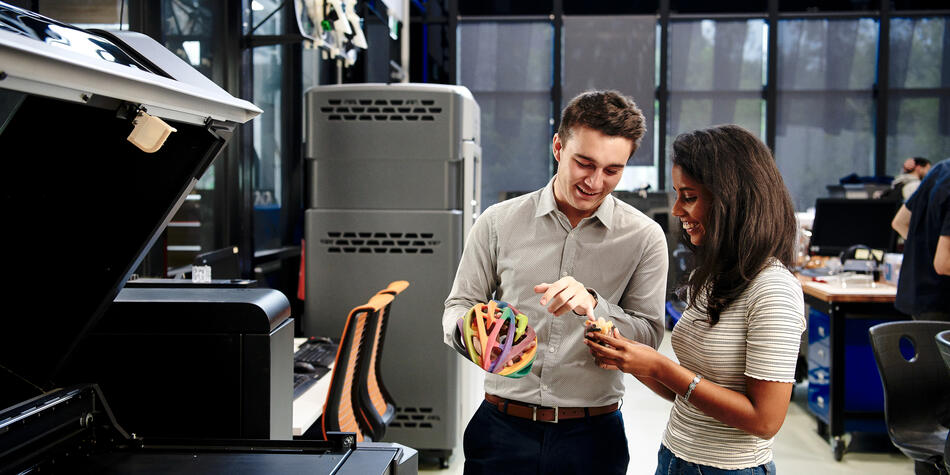Matt Zampatti enrolled in Deakin's School of Engineering as a mature-age student with a trade background. He graduated in 2018, and is now the School's Senior Technical Officer.
He is living proof that the School's project-orientated design-based teaching philosophy works. The best engineering degrees get you ready for the real world, and what better way to do this than through practical work experiences?
What is in an engineering degree?
'It's based around solving real-world engineering problems in the classroom,' Matt says. 'We take a problem that might be seen in the industry and we apply it to the learning.'
When Matt was a student, he and his classmates learned how to design a bridge by, you guessed it, designing a bridge. But this was no fanciful pie-in-the-sky bridge; their designs had to be governed by real Australian regulations and involve materials and sizes available here.
'We couldn’t just make up any bit of steel,' Matt says. Instead they had to ask: what steels do we use in Australia? What size sections? Will that section hold that load? By solving these problems the students learned common practices and industry standards that applied in the real world.
Making you employment ready
Dr Michael Pereira, Associate Professor in Mechanical Design Engineering, believes the teaching model makes students more employment ready. It ensures they are learning professional practice skills – like teamwork, communication and project management – at the same time they're learning the technical skills necessary for a career in engineering. 'With a more traditional course,' he says, '(graduates) may not be so employment-ready.'
It's based around solving real-world engineering problems in the classroom. We take a problem that might be seen in the industry and we apply it to the learning.
Matt Zampatti
Bachelor of Engineering graduate
Warring with the Warman
The School of Engineering restructured their course to include the Warman Competition because it ties in so well with their teaching philosophy.
The Warman is a design and build competition for second-year engineering students majoring in mechanical or mechatronics engineering. It's run by Engineers Australia and involves a campus competition, which pits a university's students against each other, and a national competition, where the top students from each university compete for world domination.
'The challenge is to build an autonomous machine that can take a payload from one spot to another on a set course,' Dr Pereira explains. Each year, Engineers Australia comes up with a different scenario for the pickup and disposal. So one year the payload may be energy on a distant planet, another year it may be toxic waste in the ocean.
'It’s a really cool competition,' Dr Pereira says. And, at Deakin, participation can count towards your assessment. 'It's a rare opportunity to…design, build and test something from nothing to competition.'
And, bonus, if you win the campus competition, you're off to Sydney!
Hands-on experience with real-world projects
Another opportunity to engage in real-world engineering and improve your employment opportunities while studying at Deakin is the final year project.
This is a self-managed project – either research or industry-based – in an area of your choosing. It gives you the opportunity to show the key skills you need as an engineer. And it gives you access to Deakin's digital manufacturing facility and state-of-the-art equipment to realise your vision with a rapid prototype.
Build relationships and get experience while you study
Deakin's engineering course also includes a 60-day internship, which encourages students to build relationships with engineering companies and future employers.
Matt Zampatti recalls how his background gave him a leg-up during his internship. 'I had already performed some of the calculations and assessments doing, so I could just be given the problem and then go off and do it,' he explains. 'They said, 'great, we don’t have to hold your hand.''
Things like the Warman Competition are also great experiences to talk about on your CV and in job interviews, Dr Pereira says. 'What you’ve done, what you've learnt, how you managed in a real engineering environment with a team and deadlines and finite resources.'
It's about insight and application, says Matt. And standing out from the crowd.
Leading the way in renewable energy
Standing out from the crowd is exactly what Deakin is doing with its Renewable Energy Microgrid, established in partnership with AusNet Services and Mondo Power.
The $30-million industrial-scale smart microgrid energy system is Australia's largest campus-based microgrid system. It involves the installation of more than 20,000 solar panels at the Geelong Waurn Ponds Campus – and is a key part of the university's ambition to achieve carbon neutrality.
Professor Aman Maung Than Oo, Head of Deakin's School of Engineering, is a research leader on the project. He believes the microgrid research and data could have a significant impact on government energy policy, the integration of renewable energy systems and the development of smart cities.
'Deakin is the place for engineering students and researchers who want to contribute to Australia’s sustainable infrastructure future,' he says.
Indeed, if you want to be a part of the engineering of the future, Deakin is the place for you.
Go beyond the theory and learn how to create innovative engineering solutions to real-world problems. Choose from specialisations in:

